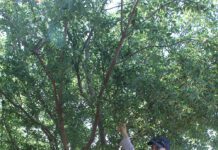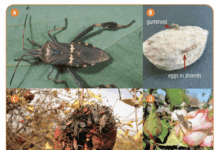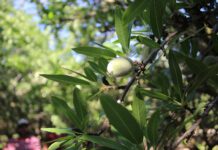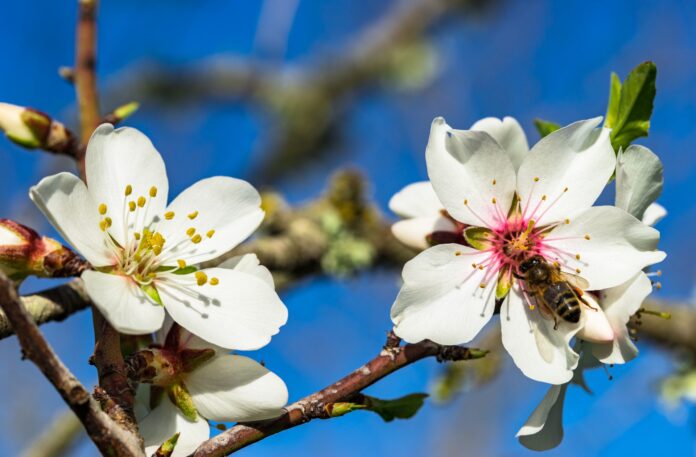
Bee populations fluctuate more dramatically every year and bee losses have gone up dramatically over the past 10 years,” said Philip Russell, president of the California State Beekeepers Association. “We don’t necessarily have a shortage of bees when it comes to satisfying California’s almond pollination needs, but there is always a shortage of ‘good-quality’ bees. Prices are expected to remain high for high-quality pollinators.”
No reduction in bee colonies is expected this year, according to Brittney Goodrich, assistant professor in the Department of Agricultural and Resource Management at UC Davis. She said there were about 2.6 million bee colonies available for almond growers last year and expects 2.7 million colonies will be available to meet the demand in 2024.
A yearly increase in bee colonies is rare, however, even a small one. Beekeepers have lost about 30% of their colonies in the U.S. every year since 2006, according to several studies.
“Beekeepers have a hard time keeping bees alive,” said Goodrich. “The varroa mite is the main pest but there are also a lot of other issues, such as lack of proper nutrition.”
“One of the contributing factors to bee health and bee loss is beekeepers are having a really difficult time finding forage for our bees in the off-season that provides them with adequate nutrition,” agreed Russell.
“Beekeepers are continually losing access to lands that were previously available to use for foraging our bees. This is the result of many factors including drought and urban sprawl. But also, there seems to be a movement against commercial bees, and it is becoming increasingly more difficult to find landowners who will allow bees on their lands to forage.
“Beekeepers coming in from out of state are also faced with high freight and other logistical costs that can limit the availability of bees,” he said. “Here in California, beekeepers are facing several challenges including pesticide exposure and difficulties in controlling pests like the varroa mite. Many of us are also losing hives to theft and bears.
“All of these factors force the beekeeper to increase the amount of nutritional substitutes and medicinal treatments into the bees,” he continued. “These challenges also increase the amount of times the bees have to be moved to find natural resources at specific times of the year. More inputs and more moving means more costs to the beekeeper that must be passed along to all pollination customers including the almond industry.”
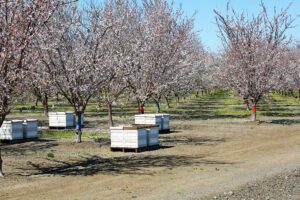
“Almond trees bloom a couple of months a year, then there’s nothing there,” said Goodrich. “It’s hard to feed bees.”
The most common food substitutes when there is no pollen or nectar available are pollen patties and sugar, according to Goodrich.
“Obviously, these food substitutes aren’t as good as the real thing: getting their food from a variety of flowers,” she said.
Indoor Storage of Bees
Goodrich believes high-tech indoor storage facilities will become increasingly important in protecting bee populations. More and more beekeepers have been moving their colonies into boxes they store in warehouses to protect them from the weather, and from the varroa mite.
“If outdoor temperatures become warm enough during the winter months (above 50 degrees F), bees will break cluster and venture out of the hive to perform cleansing flights,” according to an article from the Bee Informed Partnership (BIP). “This can reduce colony size over time since a portion of the bees who leave will not return. Those bees will also not be replaced until the queen begins laying again the following spring.”
Storing bees indoors also limits the damage caused by the varroa mite, according to BIP. Colonies kept in indoor storage facilities stop producing eggs, larvae, and pupae until they are returned to warmer conditions. Varroa mites are unable to reproduce during the bees’ “broodless period” and are much more vulnerable to chemical control treatments.
The Almond Market
“The almond industry has certainly been struggling with almond prices,” said Goodrich, “but I don’t expect that to last. We are marketing almonds all over the world. Tariffs have been dropped from key countries. As the supply chain works itself out, more almonds will be shipped out of the U.S. Hopefully, we’ll see some higher almond prices going forward.”
There are ways a grower can lower expenses, but not all of them are good ideas in the long term. Goodrich said almond growers have the option of substituting less effective bee colonies in their orchards or placing fewer colonies per acre.
“You can find cost savings there,” she said, “but you’re really in this with your beekeeper for the long haul. You should really work to maintain that relationship. Keep your beekeeper happy and you will keep them for a long time.”
Instead, Goodrich advised growers to “pay part of the pollination fee up front” and explained sometimes a beekeeper will give you a discount. She also recommended “planting a bee-friendly cover crop that will bloom before the almond trees do.”
Assistance from the Almond Industry
“The almond industry is already doing a lot to help,” said Russell. “The almond industry has promoted best management practices regarding what not to spray when bees are in the orchards and especially when bloom is occurring. They recommend application of any pesticide including fungicides should be done late in the afternoon or preferably at night. I tell growers even if they were applying water, if it is during the day, all they are doing is knocking the bees out of the trees which doesn’t help the bees, the beekeeper or the grower. These practices are up to the individual growers, but we would encourage any actions that can limit pesticide exposure to bees.”
One thing that can make a difference for an almond grower interested in ensuring they have top-quality bees for pollination by making flower cover crops available is to participate in the ‘Seeds for Bees’ program, according to Russell.
“The Seeds for Bees program provides almond growers with free seeds that can be planted in their orchards in advance of harvest,” he said. “Bees can be brought into the orchard early and the flowering cover crops give them top quality forage prior to, during and after bloom, which can be extremely beneficial to bee performance.
“This is a program sponsored by Project Apis m,” he added. “If you haven’t already talked to Josette Lewis at the Almond Board about this program, we would encourage you to do so. This really is a win-win program for both almond growers and beekeepers.
“The almond industry is also helpful in the fight against groups who are attacking the commercially managed honeybee industry. None of us want native bees or other pollinators to be hurt, but without the beekeeping industry, the entire food chain is threatened. These are the bees that need protecting right now for the security of our future.”



